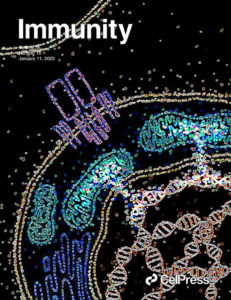MSTPublications: January 2022
 HDAC inhibitors stimulate LIFR when it is repressed by hypoxia or PTHrP in breast cancer.
HDAC inhibitors stimulate LIFR when it is repressed by hypoxia or PTHrP in breast cancer.
Edwards CM, Clements ME, Vecchi LA 3rd, Johnson JA, Johnson RW.
J Bone Oncol. 2021 Dec 1;31:100407. doi: 10.1016/j.jbo.2021.100407. eCollection 2021 Dec.
Breast cancer cells frequently disseminate to the bone marrow, where they either induce osteolysis or enter a dormant state. Downregulation of leukemia inhibitory factor receptor (LIFR), a known breast tumor suppressor, enables otherwise dormant MCF7 human breast cancer cells to become aggressively osteolytic. Hypoxia (low oxygen tensions), which may develop in tumors as a pathological response to the metabolic demands of the proliferating cells and as a physiological state in the bone, downregulates LIFR in breast cancer cells independent of hypoxia-inducible factor (HIF) signaling. However, the mechanism by which LIFR is repressed in hypoxia is unknown. Histone deacetylase (HDAC) inhibitors stimulate LIFR by increasing histone acetylation in the proximal promoter and induce a dormancy phenotype in breast cancer cells inoculated into the mammary fat pad. We therefore aimed to determine whether hypoxia alters histone acetylation in the LIFR promoter, and whether HDAC inhibitors effectively stimulate LIFR in breast cancer cells residing in hypoxic microenvironments. Herein, we confirmed that disseminated MCF7 cells became hypoxic in the bone and that hypoxia increased the epigenetic transcriptional repressor H3K9me3 in the distal LIFR promoter while H3K9ac, which promotes transcription, was significantly reduced. Furthermore, HDAC inhibitor treatment rescued hypoxic repression and dramatically increased expression of LIFR, p38β, and p21, which regulate tumor dormancy. In a second model of LIFR repression, in which parathyroid hormone-related protein (PTHrP) suppresses LIFR expression, we found that PTHrP binds to the distal LIFR promoter, and that PTHrP suppression of LIFR protein is similarly reversed by HDAC inhibitor treatment. Together, these data suggest that HDAC inhibitors stimulate LIFR regardless of the way it is repressed by the microenvironment.
 Accumbal Histamine Signaling Engages Discrete Interneuron Microcircuits.
Accumbal Histamine Signaling Engages Discrete Interneuron Microcircuits.
Manz KM, Brady LJ, Calipari ES, Grueter BA.
Biol Psychiatry. 2021 Oct 16:S0006-3223(21)01668-1. doi: 10.1016/j.biopsych.2021.10.004. Online ahead of print.
PMID: 34953589
Background: Central histamine (HA) signaling modulates diverse cortical and subcortical circuits throughout the brain, including the nucleus accumbens (NAc). The NAc, a key striatal subregion directing reward-related behavior, expresses diverse HA receptor subtypes that elicit cellular and synaptic plasticity. However, the neuromodulatory capacity of HA within interneuron microcircuits in the NAc remains unknown.
Methods: We combined electrophysiology, pharmacology, voltammetry, and optogenetics in male transgenic reporter mice to determine how HA influences microcircuit motifs controlled by parvalbumin-expressing fast-spiking interneurons (PV-INs) and tonically active cholinergic interneurons (CINs) in the NAc shell.
Results: HA enhanced CIN output through an H2 receptor (H2R)-dependent effector pathway requiring Ca2+-activated small-conductance K+ channels, with a small but discernible contribution from H1Rs and synaptic H3Rs. While PV-IN excitability was unaffected by HA, presynaptic H3Rs decreased feedforward drive onto PV-INs via AC-cAMP-PKA (adenylyl cyclase-cyclic adenosine monophosphate-protein kinase A) signaling. H3R-dependent plasticity was differentially expressed at mediodorsal thalamus and prefrontal cortex synapses onto PV-INs, with mediodorsal thalamus synapses undergoing HA-induced long-term depression. These effects triggered downstream shifts in PV-IN- and CIN-controlled microcircuits, including near-complete collapse of mediodorsal thalamus-evoked feedforward inhibition and increased mesoaccumbens dopamine release.
Conclusions: HA targets H1R, H2R, and H3Rs in the NAc shell to engage synapse- and cell type-specific mechanisms that bidirectionally regulate PV-IN and CIN microcircuit activity. These findings extend the current conceptual framework of HA signaling and offer critical insight into the modulatory potential of HA in the brain.
 Visualizing the geography of HIV observational cohorts with density-adjusted cartograms.
Visualizing the geography of HIV observational cohorts with density-adjusted cartograms.
Sack DE, Gange SJ, Althoff KN, Pettit AC, Kheshti AN, Ransby IS, Nelson JJ, Turner MM, Sterling TR, Rebeiro PF.
J Acquir Immune Defic Syndr. 2021 Dec 21. doi: 10.1097/QAI.0000000000002903. Online ahead of print.
PMID: 34974471
Background: Maps are potent tools for describing the spatial distribution of population and disease characteristics, and thereby, for appropriately targeting public health interventions. People with HIV (PWH) cluster in geographically compact and densely populated areas, which does not easily lend itself to maps that use unadjusted geographic or political borders.
Setting: To illustrate these challenges, we used geographic data from adult PWH at the Vanderbilt Comprehensive Care Clinic (VCCC), in Nashville, Tennessee, and aggregated data from the North American AIDS Cohort Collaboration on Research and Design (NA-ACCORD) from 1998-2015.
Methods: We compared choropleth maps, which use differential shading of political/geographic boundaries, and density-adjusted cartograms, which allow for shading and deformed boundaries according to a variable of interest, such as PWH.
Results: Cartograms enlarged high-burden areas and shrank low-burden areas of PWH, improving visual interpretation of where to focus HIV prevention and mitigation efforts compared to choropleth maps. Cartograms may also demonstrate cohort representativeness of underlying populations (e.g., Tennessee for VCCC or the United States for NA-ACCORD), which can guide efforts to assess external validity and improve generalizability.
Conclusion: Choropleth maps and cartograms offer powerful visual evidence of the geographic distribution of HIV disease and cohort representation and should be used to guide targeted public health interventions.
 Integrating gene expression and clinical data to identify drug repurposing candidates for hyperlipidemia and hypertension.
Integrating gene expression and clinical data to identify drug repurposing candidates for hyperlipidemia and hypertension.
Wu P, Feng Q, Kerchberger VE, Nelson SD, Chen Q, Li B, Edwards TL, Cox NJ, Phillips EJ, Stein CM, Roden DM, Denny JC, Wei WQ.
Nat Commun. 2022 Jan 10;13(1):46. doi: 10.1038/s41467-021-27751-1.
PMID: 35013250
Discovering novel uses for existing drugs, through drug repurposing, can reduce the time, costs, and risk of failure associated with new drug development. However, prioritizing drug repurposing candidates for downstream studies remains challenging. Here, we present a high-throughput approach to identify and validate drug repurposing candidates. This approach integrates human gene expression, drug perturbation, and clinical data from publicly available resources. We apply this approach to find drug repurposing candidates for two diseases, hyperlipidemia and hypertension. We screen >21,000 compounds and replicate ten approved drugs. We also identify 25 (seven for hyperlipidemia, eighteen for hypertension) drugs approved for other indications with therapeutic effects on clinically relevant biomarkers. For five of these drugs, the therapeutic effects are replicated in the All of Us Research Program database. We anticipate our approach will enable researchers to integrate multiple publicly available datasets to identify high priority drug repurposing opportunities for human diseases.

Congratulations to Ayaka Sugiura (G6) on her cover art being selected for the January issue of Immunity (pictured)!
A two-hit model of sepsis plus hyperoxia causes lung permeability and inflammation.
Bastarache JA, Smith K, Jesse JJ, Putz ND, Meegan JE, Bogart AM, Schaaf K, Ghosh S, Shaver CM, Ware LB.
Am J Physiol Lung Cell Mol Physiol. 2021 Dec 22. doi: 10.1152/ajplung.00227.2021. Online ahead of print.
Androgen receptor signaling promotes Treg suppressive function during allergic airway inflammation.
Gandhi VD, Cephus JY, Norlander AE, Chowdhury NU, Zhang J, Ceneviva ZJ, Tannous E, Polosukhin VV, Putz ND, Wickersham N, Singh A, Ware LB, Bastarache JA, Shaver CM, Chu HW, Peebles RS Jr, Newcomb DC.
J Clin Invest. 2022 Jan 13:e153397. doi: 10.1172/JCI153397. Online ahead of print.
PMID: 35025767
Development and external validation of the KIIDS-TBI tool for managing children with mild traumatic brain injury and intracranial injuries.
Greenberg JK, Ahluwalia R, Hill M, Johnson G, Hale AT, Belal A, Baygani S, Olsen MA, Foraker RE, Carpenter CR, Yan Y, Ackerman L, Noje C, Jackson E, Burns E, Sayama CM, Selden NR, Vachhrajani S, Shannon CN, Kuppermann N, Limbrick DD Jr.
Acad Emerg Med. 2021 Dec;28(12):1409-1420. doi: 10.1111/acem.14333. Epub 2021 Aug 6.
PMID: 34245632
Association of Essential Tremor With Novel Risk Loci: A Genome-Wide Association Study and Meta-analysis.
Liao C, Castonguay CE, Heilbron K, Vuokila V, Medeiros M, Houle G, Akçimen F, Ross JP, Catoire H, Diez-Fairen M, Kang J, Mueller SH, Girard SL, Hopfner F, Lorenz D, Clark LN, Soto-Beasley AI, Klebe S, Hallett M, Wszolek ZK, Pendziwiat M, Lorenzo-Betancor O, Seppi K, Berg D, Vilariño-Güell C, Postuma RB, Bernard G, Dupré N, Jankovic J, Testa CM, Ross OA, Arzberger T, Chouinard S, Louis ED, Mandich P, Vitale C, Barone P, García-Martín E, Alonso-Navarro H, Agúndez JAG, Jiménez-Jiménez FJ, Pastor P, Rajput A, Deuschl G, Kuhlenbaümer G, Meijer IA, Dion PA, Rouleau GA; 23andMe Research Team.
JAMA Neurol. 2022 Jan 4. doi: 10.1001/jamaneurol.2021.4781. Online ahead of print.
PMID: 34982113
TAAR1 regulates drug-induced reinstatement of cocaine-seeking via negatively modulating CaMKIIα activity in the NAc.
Liu J, Wu R, Seaman R Jr, Manz KM, Johnson B, Vu J, Huang Y, Zhang Y, Robison AJ, Neve R, Grueter BA, Dietz D, Li JX.
Mol Psychiatry. 2022 Jan 25. doi: 10.1038/s41380-022-01448-3. Online ahead of print.
Arrhythmia Variant Associations and Reclassifications in the eMERGE-III Sequencing Study.
Glazer AM, Davogustto GE, Shaffer CM, Vanoye CG, Desai RR, Farber-Eger E, Dikilitas O, Shang N, Pacheco JA, Yang T, Muhammad A, Mosley JD, Van Driest SL, Wells QS, Shaffer LL, Kalash OR, Wada Y, Bland S, Yoneda ZT, Mitchell DW, Kroncke BM, Kullo IJ, Jarvik GP, Gordon AS, Larson EB, Manolio TA, Mirshahi T, Luo JZ, Schaid D, Namjou B, Alsaied T, Singh R, Singhal A, Liu C, Weng C, Hripcsak G, Ralston JD, McNally EM, Chung WK, Carrell DS, Leppig KA, Hakonarson H, Sleiman P, Sohn S, Glessner J, Denny J, Wei WQ, George A Jr, Shoemaker MB, Roden DM; eMERGE Network.
Circulation. 2021 Dec 21. doi: 10.1161/CIRCULATIONAHA.121.055562. Online ahead of print.
Early-Onset Atrial Fibrillation and the Prevalence of Rare Variants in Cardiomyopathy and Arrhythmia Genes.
Yoneda ZT, Anderson KC, Quintana JA, O’Neill MJ, Sims RA, Glazer AM, Shaffer CM, Crawford DM, Stricker T, Ye F, Wells Q, Stevenson LW, Michaud GF, Darbar D, Lubitz SA, Ellinor PT, Roden DM, Shoemaker MB.
JAMA Cardiol. 2021 Dec 1;6(12):1371-1379. doi: 10.1001/jamacardio.2021.3370.
PMID: 34495297
Class switching and high-affinity immunoglobulin G production by B cells is dispensable for the development of hypertension in mice.
Chen Y, Dale BL, Alexander MR, Xiao L, Ao M, Pandey AK, Smart CD, Davis GK, Madhur MS.
Cardiovasc Res. 2021 Mar 21;117(4):1217-1228. doi: 10.1093/cvr/cvaa187.
PMID: 32609312
Current and lifetime somatic symptom burden among transition-aged autistic young adults.
Williams ZJ, Gotham KO.
Autism Res. 2022 Jan 12. doi: 10.1002/aur.2671. Online ahead of print.
PMID: 35019241
The Purkinje-myocardial junction is the anatomical origin of ventricular arrhythmia in CPVT
Blackwell DJ, Faggioni M, Wleklinski MJ, Gomez-Hurtado N, Venkataraman R, Gibbs CE, Baudenbacher FJ, Gong S, Fishman GI, Boyle PM, Pfeifer K, Knollmann BC.
JCI Insight. 2022 Jan 6:e151893. doi: 10.1172/jci.insight.151893. Online ahead of print.
PMID: 34990403
Microenvironmental influences on T cell immunity in cancer and inflammation.
Heintzman DR, Fisher EL, Rathmell JC.
Cell Mol Immunol. 2022 Jan 17. doi: 10.1038/s41423-021-00833-2. Online ahead of print.
PMID: 35039633 Review.
Genetic contributions to suicidal thoughts and behaviors.
DiBlasi E, Kang J, Docherty AR.
Psychol Med. 2021 Oct;51(13):2148-2155. doi: 10.1017/S0033291721001720. Epub 2021 May 25.
PMID: 34030748 Review.
Gene therapy for kidney disease: targeting cystinuria.
Peek JL, Wilson MH.
Curr Opin Nephrol Hypertens. 2021 Dec 15. doi: 10.1097/MNH.0000000000000768. Online ahead of print.
PMID: 34982522
BDNF signaling in context: From synaptic regulation to psychiatric disorders.
Wang CS, Kavalali ET, Monteggia LM.
Cell. 2021 Dec 21:S0092-8674(21)01425-2. doi: 10.1016/j.cell.2021.12.003. Online ahead of print.
PMID: 34963057 Review.
